Effect of Initial Granular Structure on the Evolution of Contact Force Chains
Abstract
1. Introduction
2. Materials and Methods
2.1. Digital Photoelasticity
2.2. Photoelastic Model Particles and Test Program
2.2.1. Photoelastic Model Particles
2.2.2. Experimental Setup and Test Program
3. Results and Discussion
3.1. Effect of Initial Granular Assembly Conditions on the Structure of the Contact Force Chain
3.2. Effect of Initial Granular Assembly Conditions on the Bearing Capacities of Shallow Foundations
3.3. Evolution of Structural Imperfections under Shallow Foundation Loading
4. Conclusions
Author Contributions
Funding
Acknowledgments
Conflicts of Interest
References
- Antony, S.J. Evolution of force distribution in three-dimensional granular media. Phys. Rev. E 2000, 63, 11302. [Google Scholar] [CrossRef] [PubMed]
- Bardet, J.-P. Observations on the effects of particle rotations on the failure of idealized granular materials. Mech. Mater. 1994, 18, 159–182. [Google Scholar] [CrossRef]
- Bourrier, F.; Nicot, F.; Darve, F. Physical processes within a 2D granular layer during an impact. Granul. Matter 2008, 10, 415–437. [Google Scholar] [CrossRef]
- Calvetti, F.; Combe, G.; Lanier, J. Experimental micromechanical analysis of a 2D granular material: Relation between structure evolution and loading path. Mech. Cohesive-frictional Mater. An Int. J. Exp. Model. Comput. Mater. Struct. 1997, 2, 121–163. [Google Scholar] [CrossRef]
- Ciamarra, M.P.; Coniglio, A.; Nicodemi, M. Shear instabilities in granular mixtures. Phys. Rev. Lett. 2005, 94, 188001. [Google Scholar] [CrossRef]
- Kondic, L.; Fang, X.; Losert, W.; O’Hern, C.S.; Behringer, R.P. Microstructure evolution during impact on granular matter. Phys. Rev. E 2012, 85, 11305. [Google Scholar] [CrossRef]
- Oda, M.; Kazama, H.; Konishi, J. Effects of induced anisotropy on the development of shear bands in granular materials. Mech. Mater. 1998, 28, 103–111. [Google Scholar] [CrossRef]
- Peters, J.F.; Muthuswamy, M.; Wibowo, J.; Tordesillas, A. Characterization of force chains in granular material. Phys. Rev. E 2005, 72, 41307. [Google Scholar] [CrossRef]
- Majmudar, T.S.; Behringer, R.P. Contact force measurements and stress-induced anisotropy in granular materials. Nature 2005, 435, 1079–1082. [Google Scholar] [CrossRef]
- Tordesillas, A.; Zhang, J.; Behringer, R. Buckling force chains in dense granular assemblies: Physical and numerical experiments. Geomech. Geoengin. An Int. J. 2009, 4, 3–16. [Google Scholar] [CrossRef]
- Oda, M.; Kazama, H. Microstructure of shear bands and its relation to the mechanisms of dilatancy and failure of dense granular soils. Geotechnique 1998, 48, 465–481. [Google Scholar] [CrossRef]
- Rechenmacher, A.L. Grain-scale processes governing shear band initiation and evolution in sands. J. Mech. Phys. Solids 2006, 54, 22–45. [Google Scholar] [CrossRef]
- Rechenmacher, A.; Abedi, S.; Chupin, O. Evolution of force chains in shear bands in sands. Geotechnique 2010, 60, 343. [Google Scholar] [CrossRef]
- Thornton, C.; Zhang, L. A numerical examination of shear banding and simple shear non-coaxial flow rules. Philos. Mag. 2006, 86, 3425–3452. [Google Scholar] [CrossRef]
- Aharonov, E.; Sparks, D. Stick-slip motion in simulated granular layers. J. Geophys. Res. Solid Earth 2004, 109. [Google Scholar] [CrossRef]
- Tordesillas, A. Force chain buckling, unjamming transitions and shear banding in dense granular assemblies. Philos. Mag. 2007, 87, 4987–5016. [Google Scholar] [CrossRef]
- Chen, F.; Zhuang, Q.; Zhang, H. Mechanical analysis and force chain determination in granular materials using digital image correlation. Appl. Opt. 2016, 55, 4776–4783. [Google Scholar] [CrossRef]
- Muthuswamy, M.; Tordesillas, A. How do interparticle contact friction, packing density and degree of polydispersity affect force propagation in particulate assemblies? J. Stat. Mech. Theory Exp. 2006, 2006, P09003. [Google Scholar] [CrossRef]
- Xiu, T.-X.; Wang, W.; Liu, K.; Wang, Z.-Y.; Wei, D.-Z. Characteristics of force chains in frictional interface during abrasive flow machining based on discrete element method. Adv. Manuf. 2018, 6, 355–375. [Google Scholar] [CrossRef]
- Maeda, K.; Sakai, H.; Kondo, A.; Yamaguchi, T.; Fukuma, M.; Nukudani, E. Stress-chain based micromechanics of sand with grain shape effect. Granul. Matter 2010, 12, 499–505. [Google Scholar] [CrossRef]
- Park, K.H.; Jung, Y.H. Quantitative Detection of Contact Force Chains in a Model Particle Assembly Using Digital RGB Photoelastic Measurements. KSCE J. Civ. Eng. 2019. accepted. [Google Scholar]
- Wakabayashi, T. Photo-elastic method for determination of stress in powdered mass. J. Phys. Soc. Japan 1950, 5, 383–385. [Google Scholar] [CrossRef]
- Dantu, P. Contribution à l’étude mécanique et géométrique des milieux pulvérulents. In Proceedings of the 4th ICSMFE, London, UK, 12–24 August 1957. [Google Scholar]
- Drescher, B.A. Photoelastic verification of a mechanical model for the flow of a granular material. J. Mech. Phys. Solids 1972, 20, 337–340. [Google Scholar] [CrossRef]
- Liu, C.; Nagel, S.R.; Schecter, D.A.; Coppersmith, S.N.; Majumdar, S.; Narayan, O.; Witten, T.A. Force fluctuations in bead packs. Science (80-.) 1995, 269, 513–515. [Google Scholar] [CrossRef]
- Howell, D.; Behringer, R.P.; Veje, C. Stress fluctuations in a 2D granular Couette experiment: A continuous transition. Phys. Rev. Lett. 1999, 82, 5241. [Google Scholar] [CrossRef]
- Hayman, N.W.; Ducloué, L.; Foco, K.L.; Daniels, K.E. Granular Controls on Periodicity of Stick-Slip Events: Kinematics and Force-Chains in an Experimental Fault. Pure Appl. Geophys. 2011, 168, 2239–2257. [Google Scholar] [CrossRef]
- Daniels, K.E.; Kollmer, J.E.; Puckett, J.G. Photoelastic force measurements in granular materials. Rev. Sci. Instrum. 2017, 88. [Google Scholar] [CrossRef]
- Ajovalasit, A.; Petrucci, G. Analisi automatica delle frange fotoelastiche in luce bianca. In Proceedings of the XVIII AIAS Conference; Istituto di Ingegneria Meccanica, Universitàdi Salerno: Salerno, Italy, 1990; pp. 395–407. [Google Scholar]
- Ajovalasit, A.; Barone, S.; Petrucci, G. Towards RGB photoelasticity: Full-field automated photoelasticity in white light. Exp. Mech. 1995, 35, 193–200. [Google Scholar] [CrossRef]
- Ajovalasit, A.; Petrucci, G.; Scafidi, M. RGB photoelasticity: Review and improvements. Strain 2010, 46, 137–147. [Google Scholar] [CrossRef]
- Ajovalasit, A.; Petrucci, G.; Scafidi, M. RGB photoelasticity applied to the analysis of membrane residual stress in glass. Meas. Sci. Technol. 2011, 23, 25601. [Google Scholar] [CrossRef]
- Byeon, B.-H.; Jung, Y.-H. Measurement of stress and displacement fields in particle assembly subjected to shallow foundation loading via photoelasticity technique. J. Korean Soc. Civ. Eng. 2013, 33, 1947–1955. [Google Scholar] [CrossRef]
- Cates, M.E.; Wittmer, J.P.; Bouchaud, J.-P.; Claudin, P. Jamming and static stress transmission in granular materials. Chaos An Interdiscip. J. Nonlinear Sci. 1999, 9, 511–522. [Google Scholar] [CrossRef] [PubMed]
- Blumenfeld, R. Stresses in isostatic granular systems and emergence of force chains. Phys. Rev. Lett. 2004, 93, 108301. [Google Scholar] [CrossRef] [PubMed]
- Josselin de Jong, G.D.; Verruijt, A. Etude Photo Elastique d’un Depilement de Disques. Cah. Grpe. Fr. Etud. Rheol 1969, 2, 73–86. [Google Scholar]
- Tordesillas, A.; Steer, C.A.H.; Walker, D.M. Force chain and contact cycle evolution in a dense granular material under shallow penetration. Nonlinear Process. Geophys. 2014, 21, 505–519. [Google Scholar] [CrossRef]
- Tordesillas, A.; Muthuswamy, M. On the modeling of confined buckling of force chains. J. Mech. Phys. Solids 2009, 57, 706–727. [Google Scholar] [CrossRef]
- Adrian, R.J. Particle-imaging techniques for experimental fluid mechanics. Annu. Rev. Fluid Mech. 1991, 23, 261–304. [Google Scholar] [CrossRef]
- Kwak, T.Y.; Woo, S.I.; Kim, J.; Chung, C.-K. Model test assessment of the generation of underground cavities and ground cave-ins by damaged sewer pipes. Soils Found. 2019. [Google Scholar] [CrossRef]

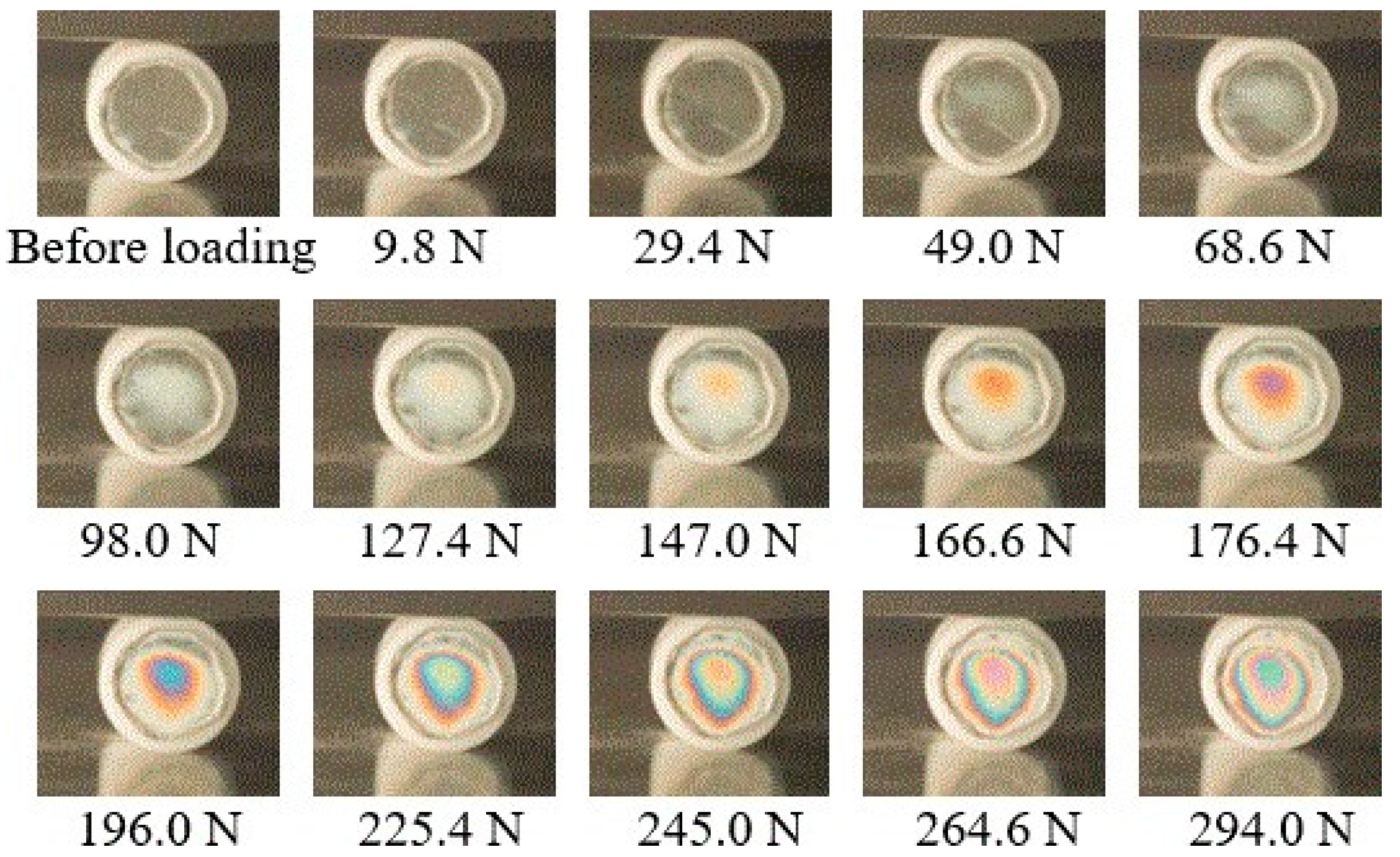
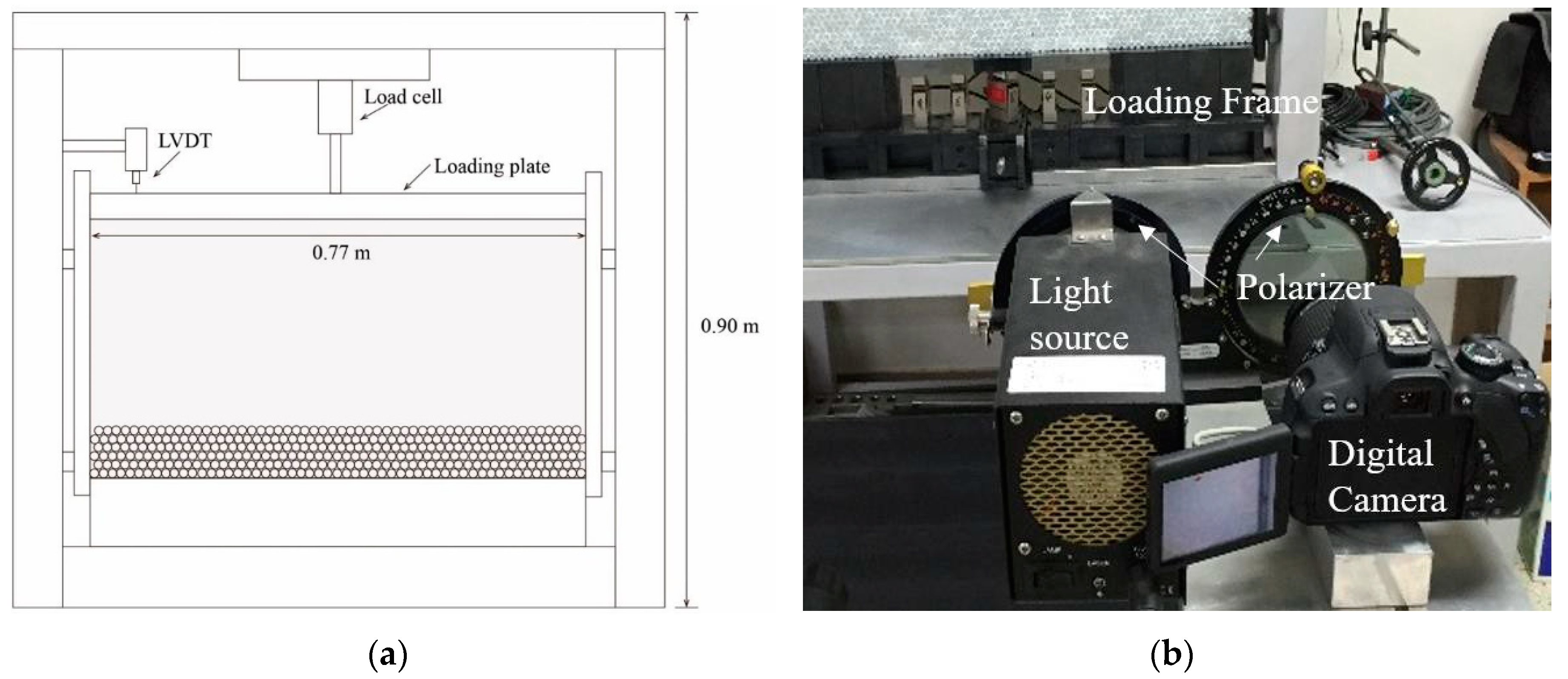


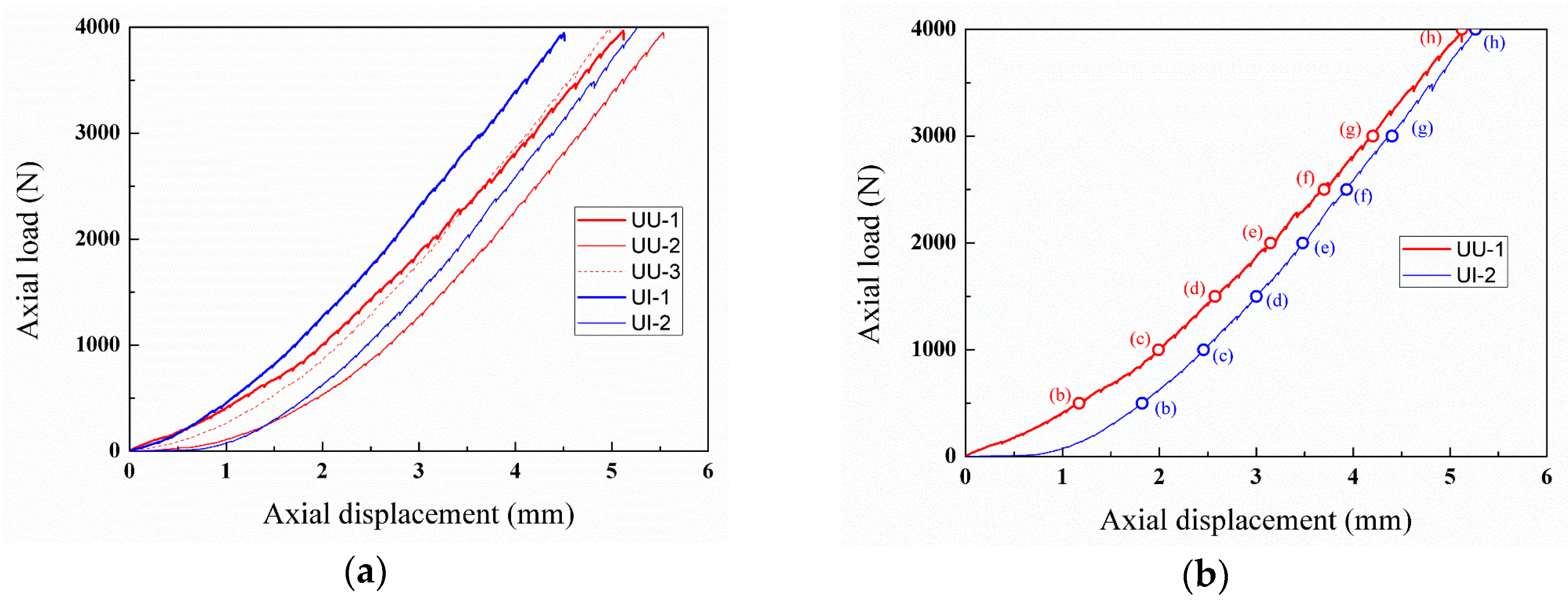

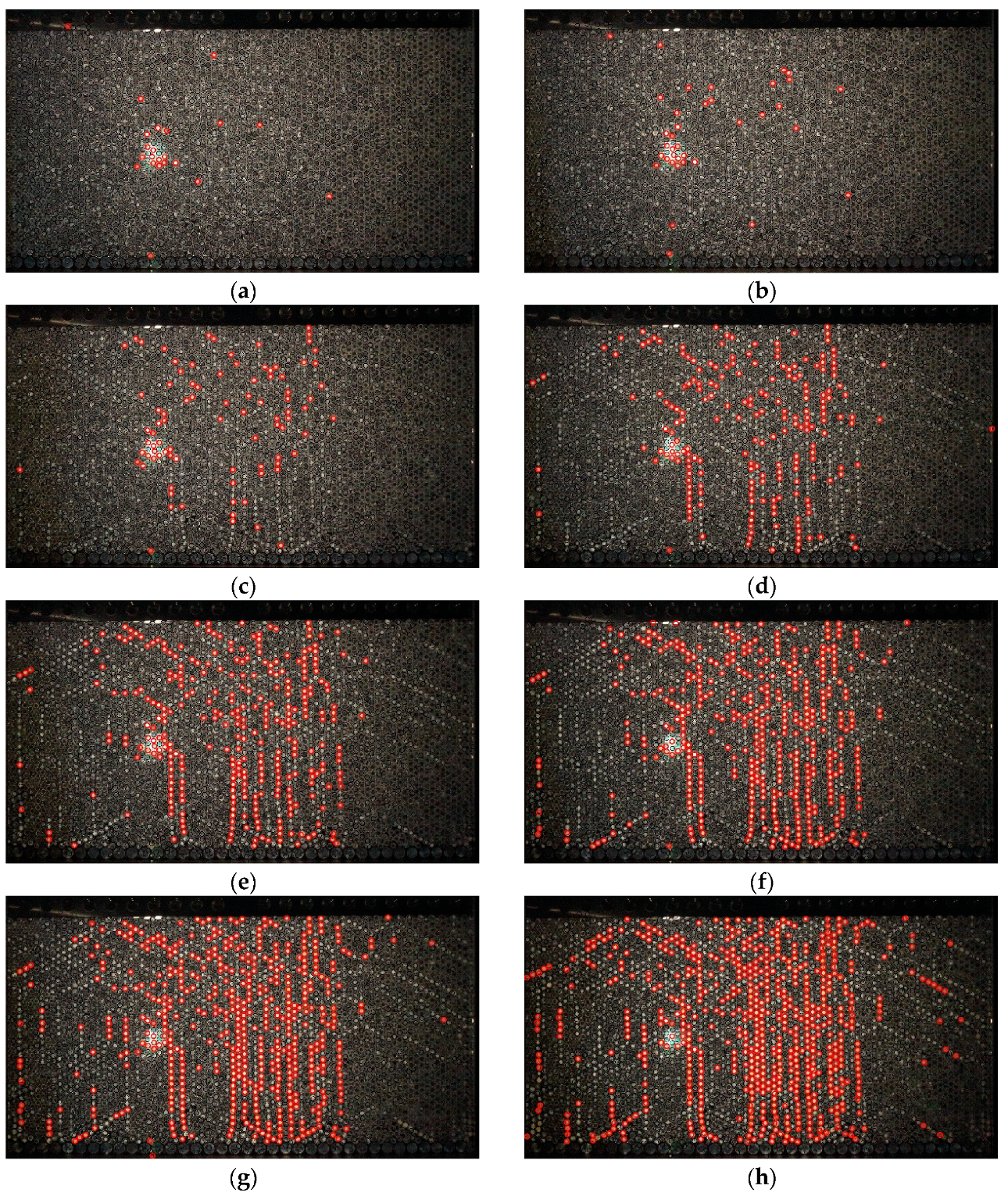




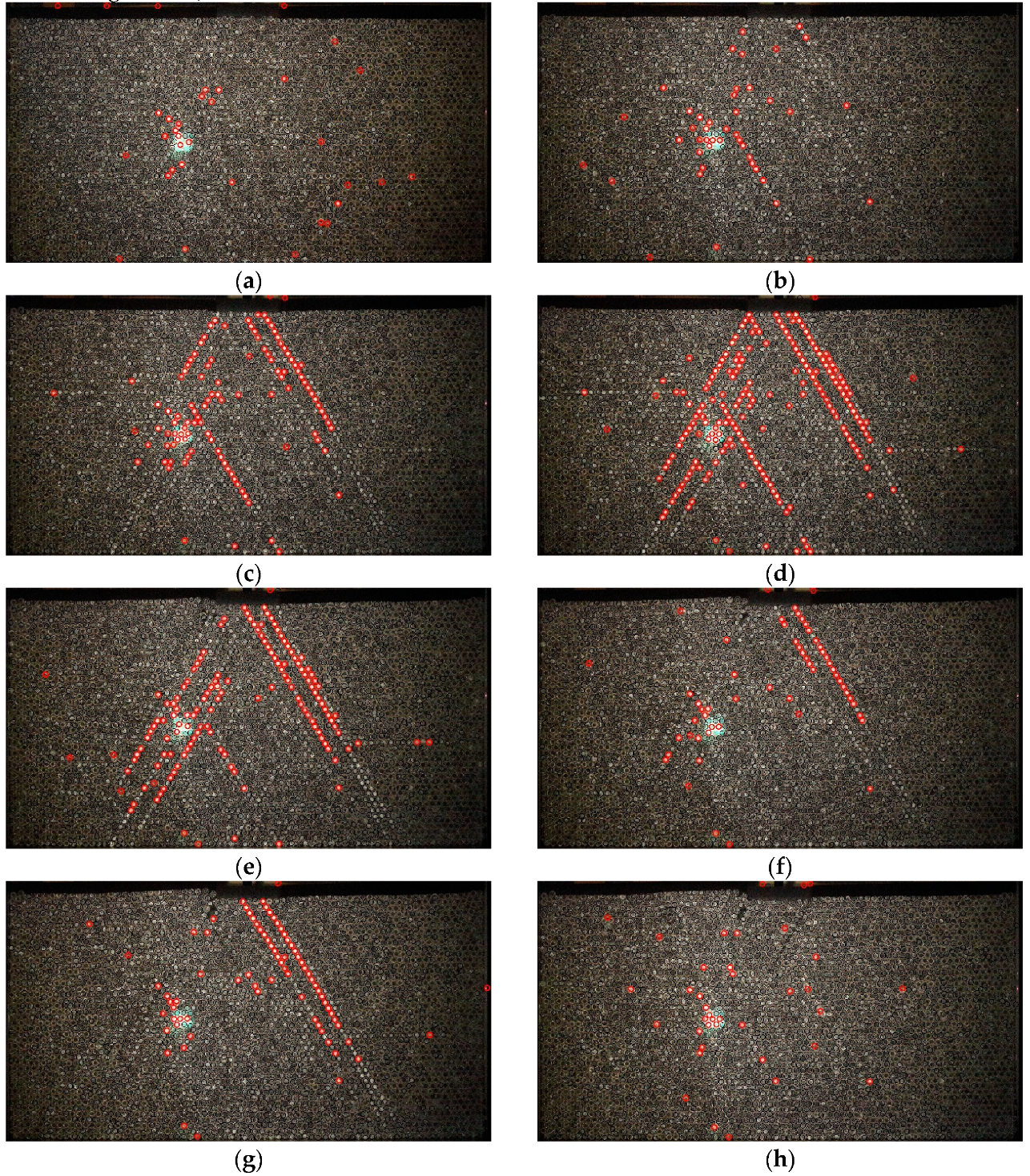
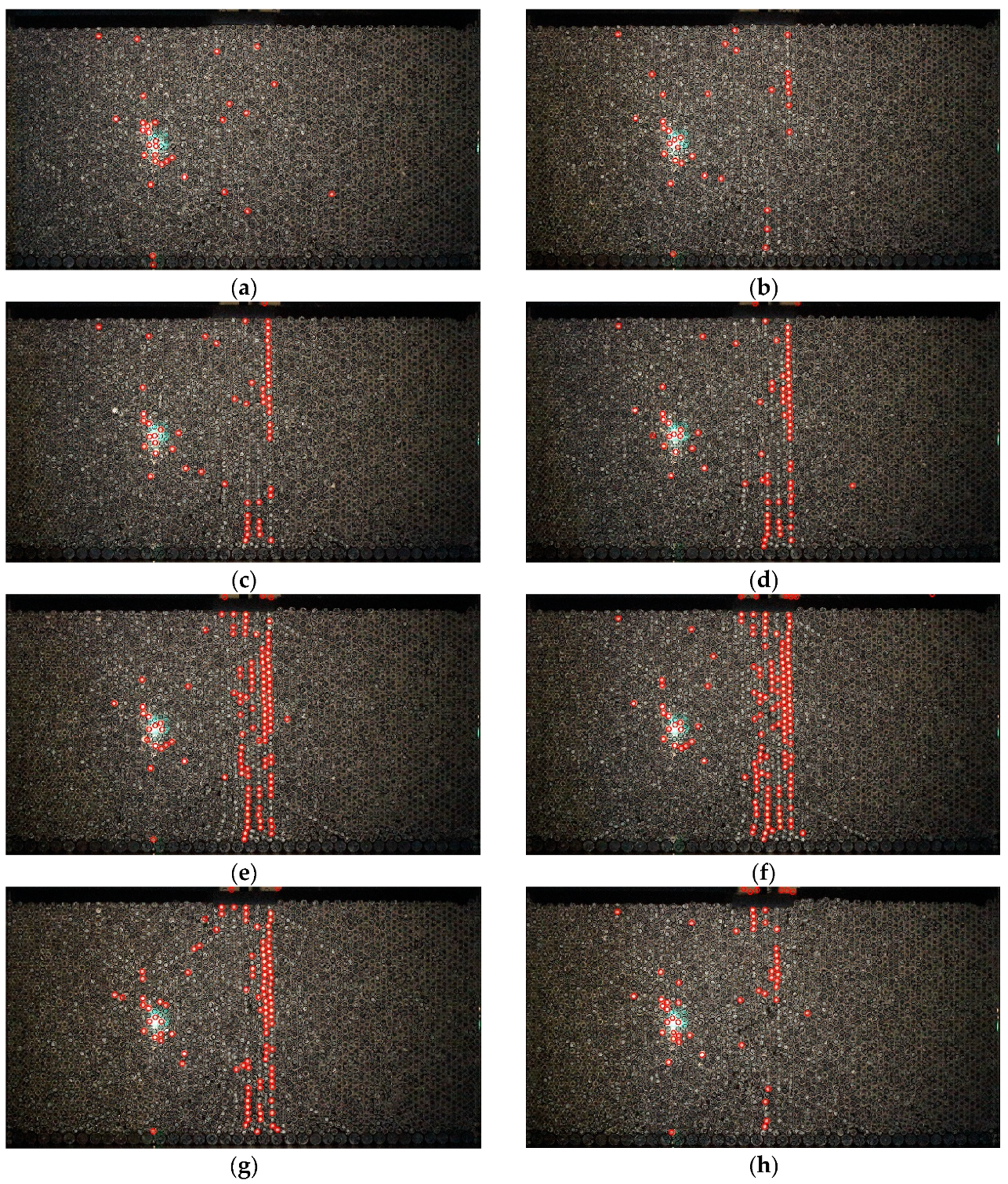


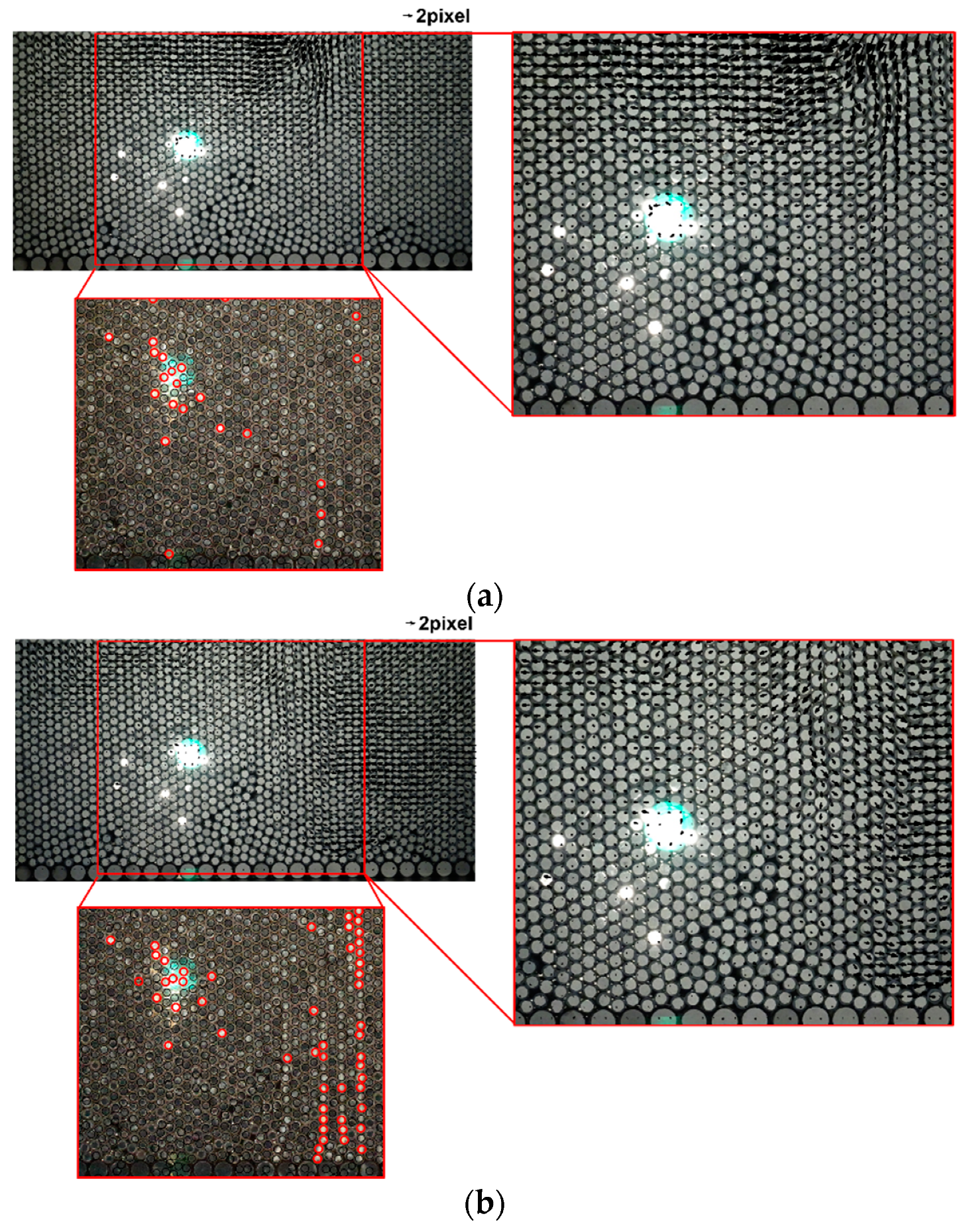
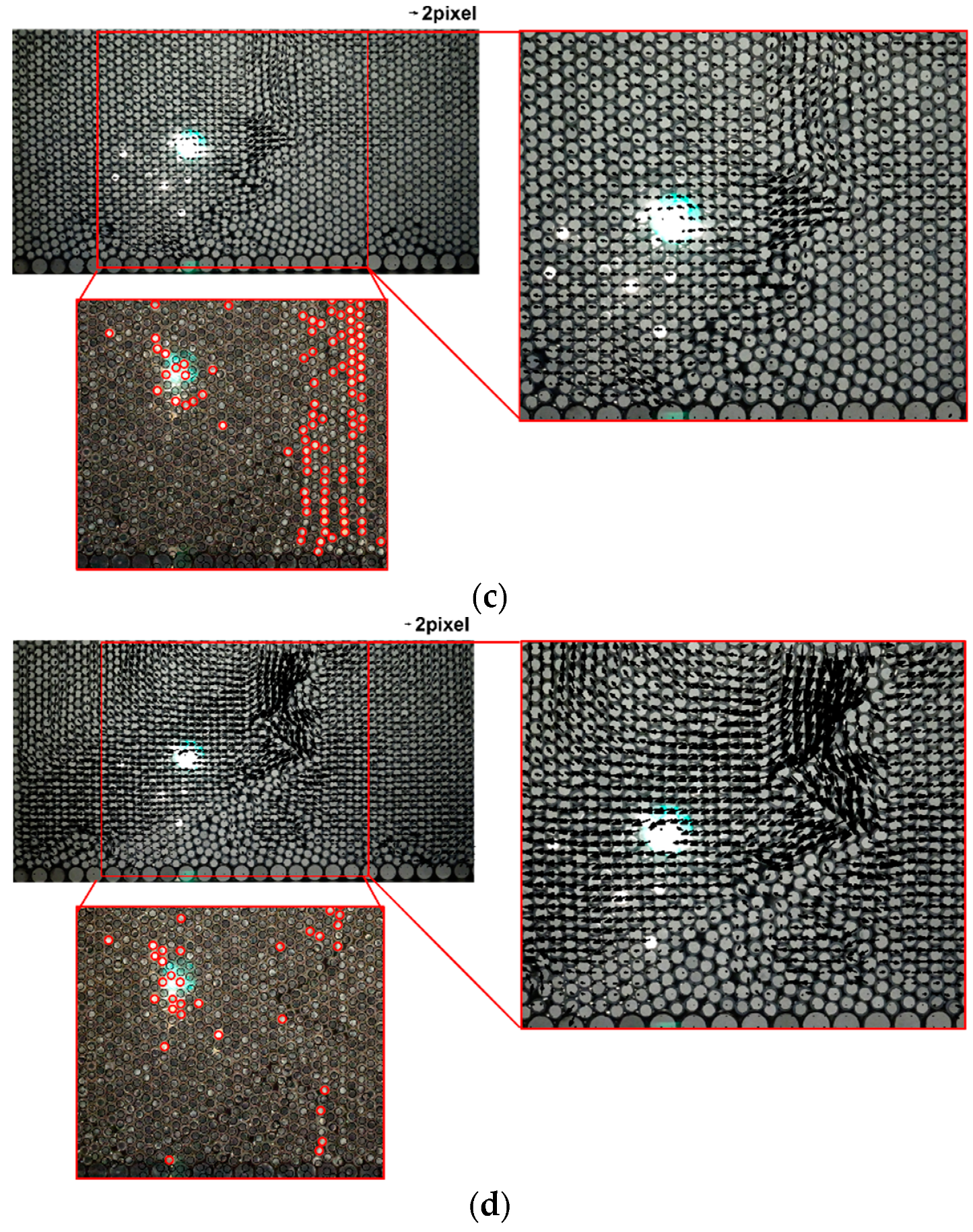
| Test ID | Loading Condition | Packing Condition | No. of Repetitions |
|---|---|---|---|
| UU | Uniaxial (U) | Uniform structure w/o imperfection (U) | 3 |
| UI | Structure w/ imperfections (I) | 2 | |
| SU | Shallow foundation (S) | Uniform structure w/o imperfection (U) | 3 |
| SI | Structure w/ imperfections (I) | 3 |
| Test ID: SU | Images | |||||||
|---|---|---|---|---|---|---|---|---|
| (a) | (b) | (c) | (d) | (e) | (f) | (g) | (h) | |
| Axial load (N) | 0 | 200 | 400 | 600 | 450 | 200 | 350 | 20 |
| Displacement (mm) | 0 | 5.08 | 6.3 | 7.21 | 7.52 | 7.78 | 8.98 | 9.81 |
| Average particle force in overall assembly (N) | 33 | 33 | 36 | 40 | 37 | 33 | 35 | 33 |
| Particle frequency in overall assembly | 2,910 | 2,883 | 2,868 | 2,881 | 2,830 | 2,869 | 2,883 | 2,934 |
| Total force in overall assembly | 96,030 | 95,139 | 103,248 | 115,240 | 104,710 | 94,677 | 100,905 | 96,822 |
| Average particle force in the main force chain (N) | - | 136 | 127 | 127 | 130 | 130 | 133 | 146 |
| Particle frequency in the main force chain | - | 44 | 109 | 186 | 139 | 55 | 77 | 38 |
| Total force in the main force chain | - | 5,984 | 13,843 | 23,622 | 18,070 | 7,150 | 10,241 | 5,548 |
| Test ID: SI | (a) | (b) | (c) | (d) | (e) | (f) | (g) | (h) |
| Axial load (N) | 0 | 100 | 200 | 300 | 400 | 450 | 370 | 170 |
| Displacement (mm) | 0 | 2.57 | 3.22 | 4 | 4.96 | 5.29 | 5.83 | 7.81 |
| Average particle force in overall assembly (N) | 32 | 32 | 31 | 30 | 33 | 34 | 32 | 32 |
| Particle frequency in overall assembly | 2887 | 2878 | 2813 | 2720 | 2752 | 2771 | 2765 | 2828 |
| Total force in overall assembly | 92,384 | 92,096 | 87,203 | 81,600 | 90,816 | 94,214 | 88,480 | 90,496 |
| Average particle force in the main force chain (N) | - | 123 | 124 | 130 | 129 | 130 | 129 | 132 |
| Particle frequency in the main force chain | - | 34 | 58 | 75 | 114 | 141 | 102 | 55 |
| Total force in the main force chain | - | 4182 | 7192 | 9750 | 14,706 | 18,330 | 13,158 | 7260 |
© 2019 by the authors. Licensee MDPI, Basel, Switzerland. This article is an open access article distributed under the terms and conditions of the Creative Commons Attribution (CC BY) license (http://creativecommons.org/licenses/by/4.0/).
Share and Cite
Park, K.-H.; Jung, Y.-H.; Kwak, T.-Y. Effect of Initial Granular Structure on the Evolution of Contact Force Chains. Appl. Sci. 2019, 9, 4735. https://doi.org/10.3390/app9224735
Park K-H, Jung Y-H, Kwak T-Y. Effect of Initial Granular Structure on the Evolution of Contact Force Chains. Applied Sciences. 2019; 9(22):4735. https://doi.org/10.3390/app9224735
Chicago/Turabian StylePark, Ka-Hyun, Young-Hoon Jung, and Tae-Young Kwak. 2019. "Effect of Initial Granular Structure on the Evolution of Contact Force Chains" Applied Sciences 9, no. 22: 4735. https://doi.org/10.3390/app9224735
APA StylePark, K.-H., Jung, Y.-H., & Kwak, T.-Y. (2019). Effect of Initial Granular Structure on the Evolution of Contact Force Chains. Applied Sciences, 9(22), 4735. https://doi.org/10.3390/app9224735





